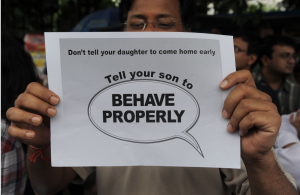I still remember when I first heard about CAP conference in September, i didn’t think i would actually go attend it, because I have never been really confident enough or interested in public speaking and presenting at conferences. But throughout the year in CAP I found myself challenged time and again to step out of my comfort zone and speak up. Responding to these challenges over time made me get used to them. Thus when my team mates from my ASTU class’s archives project ask me if I wanted to present our project at CAPCON with them, I didn’t have to think twice, I knew it was something I could do and something I wanted to do.
At the conference when I wasn’t presenting our project, I got the opportunity to listen to some of my peers from different CAP streams. One of the presentations that really struck a chord with me was that of Sepideh Najarnia’s essay on “Sport Riots: The role of Dictatorship”. She was presenting under panel A: ‘Violence and the Environment’. Her paper focused on how people living in countries under dictatorship rule, use sports riots as a means of letting out their anger and frustration about larger social issues such as dissatisfaction with the current regime. Why can’t they just protest on the streets about their main agendas? why can they only let it out by masking it under a false pretence of some so called ‘sports riots’? She explained the detrimental consequences that lead to a huge loss of thousands of innocent lives when people tried to take a more direct approach to expressing their disapproval towards the current regime.
What I found intriguing about her presentation was the personal touch she added to her essay. She did so by bringing in examples of Iran, her home country, into the essay to make her point more clear. Having lived in Iran all her life and having experienced such riots and demonstrations in her home country she was able to draw attention of her audience by backing her argument with real life examples. She talked about her home country, first revising the dominant perceptions about Iran people usually hold and then pointing out what is not known or left out because the reporters don’t have the freedom to express the truth openly. Such representation works to bridge the gap between what is known through the dominant patterns of representation represented in mass media and that which is largely unknown and represents the perspective of the marginalized living in that specific country.
Hearing her talk about her country in such a way made me think of my home country, Pakistan. I could relate to her because Pakistan has also been going through political unrest in the past few years and what mass media portrays about my country and what actually goes on in my country, are two very different perspectives of the same scenario. Throughout the year I experienced various instances, where some of my peers didn’t know much about my country and even if they did, talking to them would reveal how they only knew a portion of the truth about my country. The truth was quite often then not hidden beneath layers of dominant media representations, the things they read on social media. I never blamed them for not knowing enough because I finally began to understand how news travelled around the world. All my classes in Cap highlighted these issues of misrepresentation and power politics in one way or another.Whose voice is heard? and whose voice is suppressed?. It is because of these inequalities in media representation that I decided to try to bridge the gap between the known and the unknown about my country, be it in the realm of social, cultural or political issues. I used every opportunity that came my way, starting from first blog in ASTU class where I shed light on the details of a terrorist attack in a city of Pakistan, to class discussions about cultural norms regarding female education and social trends in Pakistan.
I tried to do my job as Pakistani student studying abroad. I remember last September, we were asked what it meant to be a ‘Global Citizen’ and I just put down a generic definition, but if asked now I would like to mould that definition slightly. I have learnt enough in CAP ‘Global Citizens’ stream to be able to say confidently that a ‘Global Citizen’ is a person who is aware of the growing inequalities around the world. He doesn’t give up his national or ethnic identity to be more involved in the global realm but rather tries to act as an unofficial ambassador for his country at an international level. And I believe coming to UBC and representing my country among other international students from around the world I have tried to do justice to my role as a ‘Global Citizen’.
